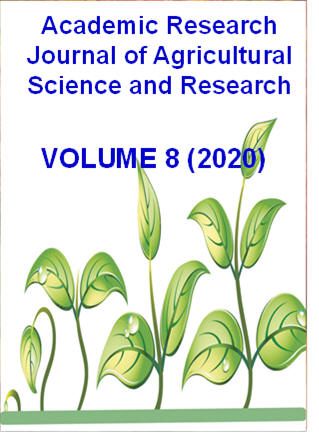|
ISSN: 2360-7874 |
Academic Research Journal of
Agricultural Science and Research |
|||||||||||||||||||
|
Vol. 8(6), pp. 609-618, August 2020 Research Effect of Blended NPS Fertilizer Levels and Row Spacing on Yield Components and Yield of Food Barley (Hordeum Vulgare L.) at High Land of Guji Zone, Southern Ethiopia.
Yared Tesfaye*, Seyoum Alemu, Kabna Asefa, Girma Teshome and, Obsa Chimdesa
Oromia Agricultural Research Institute (OARI), Bore Agricultural Research Center, P O Box 21, Bore, Ethiopia. Corresponding author’s Email: yaredtesfa1990@gmail.com
Accepted 30 August 2020
Barely (Hordeum Vulgare L.) is one of the most important food crops produced in the world in general and in specific in Ethiopia. Even though it is such an important cereal crops in Ethiopia, it is giving low yield due to many production constraints such as lack of improved varieties, poor agronomic practice (inappropriate fertilizer rate and row spacing), diseases, weeds and low soil fertility in Ethiopia in general and in Guji zone in particular. Therefore, field experiment was conducted during the 2016-2017 main cropping season at Bore and Ana sora to assess the effect of NPS rate and row spacing on yield components and yield of barley; and to determine appropriate NPS rates and row spacing for barley. The experiment was laid out RCBD in a factorial arrangement with three replications using a barley variety known as ‘HB-1307’ as a test crop. The treatments consisted of five levels of NPS rate (0, 30, 60 and 120 kg ha-1) and four levels of row spacing (15, 20, 25 and 30 cm) consisting a total of 20 treatments. Analysis of the results revealed that days to 50% heading, days to 90% maturity, spike length and number of tiller per plant were significantly (P<0.05) affected by the interaction of NPS x location well as the interaction of spacing x location. Similarly the interaction of the three factors (NPS x Spacing x location) were significantly (P<0.05) affected grain yield and thousand kernel weight of barley. The maximum grain yield (3618kg/ha) and the highest kernels weight (53.47g) was recorded at combined application of 120 kg/ha NPS and 20 cm spacing at Bore and 120kg/ha NPS and 25cm spacing at Ana sora respectively. But the interaction effect of NPS x Spacing x location, NPS x location, Spacing x location and the main effect of NPS, Spacing and location did not significantly affected plant height and number of productive tiller. The partial budget analysis revealed that combined applications of 120 kg NPS kg/ha and 20cm spacing gave the best economic benefit 18855.45 Birr ha-1 with MRR of 1071.9%. Therefore, on economic grounds application of NPS 120kg/ha with 20cm spacing would be best and economical and can be recommended for production of barley in the study area.
Keywords: Fertilizer, Interaction, Interaction effect, Main effect, Nutrient
How to
cite this article (APA Style):
Yared T., Seyoum A., Kabna A., Girma T., Obsa C. (2020). Effect of
Blended NPS Fertilizer Levels and Row Spacing on Yield Components and
Yield of Food Barley (Hordeum Vulgare L.) at High Land of Guji
Zone, Southern Ethiopia.. Acad. Res. J. Agri. Sci. Res. 8(6): 609-618
|
|||||||||||||||||||
